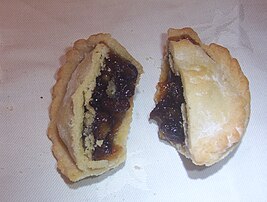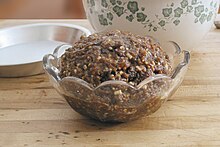What Is Beef in None Such Mincemeat

Mincemeat is a mixture of chopped dried fruit, distilled spirits and spices, and often beef suet, usually used as a pie or pastry filling. Mincemeat formerly contained meat, notably beef or venison.[1] Many modernistic recipes replace the suet with vegetable shortening. Mincemeat is found in the Anglosphere.
Etymology [edit]
The "mince" in mincemeat comes from the Middle English mincen, and the Old French mincier both traceable to the Vulgar Latin minutiare, meaning chop finely. The word mincemeat is an adaptation of an earlier term minced meat, meaning finely chopped meat. Meat was likewise a term for food in general, not only animate being flesh.[ii]
Variants and history [edit]

English recipes from the 15th, 16th, and 17th centuries describe a fermented mixture of meat and fruit used every bit a pie filling. These early recipes included vinegars and wines, but by the 18th century, distilled spirits, frequently brandy, were existence used instead. The use of spices like clove, nutmeg, mace and cinnamon was mutual in late medieval and renaissance meat dishes. The increase of sweet from added sugar made mincemeat less a savoury dinner course and helped to direct its use toward desserts.
16th-century recipe [edit]
Pyes of mutton or beif must be fyne mynced & seasoned with pepper and salte and a lytel saffron to colour it / suet or marrow a good quantitie / a lytell vynegre / pruynes / great reasons / and dates / accept the fattest of the broath of powdred beefe. And if yous will have paest royall / take butter and yolkes of egges & so to temper the floure to make the paest. [3]
Pies of mutton or beefiness must exist finely minced and seasoned with pepper and salt, and a little saffron to colour it. [Add together] a good quantity of suet or marrow, a trivial vinegar, prunes, raisins and dates. [Put in] the fattest of the goop of salted beef. And, if you want Royal pastry, take butter and egg yolks and [combine them with] flour to make the paste.
In the mid- to belatedly eighteenth century, mincemeat in Europe had become associated with quondam-fashioned, rural, or homely foods. Victorian England rehabilitated the preparation equally a traditional Yuletide care for.
19th-century recipe [edit]

Late-19th-century commercial mincemeat package
Ingredients — 2 lb. of raisins, 3 lb. currants, 1+ 1⁄2 lb. of lean beef, iii lb. of beef suet, 2 lb. of moist sugar, ii oz. of citron, 2 oz. of candy-coated lemon-peel, two oz. of candied orangish-peel, 1 small nutmeg, 1 pottle of apples, the rind of 2 lemons, the juice of 1, i⁄2 pint of brandy.
Mode — Stone and cutting the raisins in one case or twice across, just practice non chop them; wash, dry, and pick the currants complimentary from stalks and dust, and mince the beef and suet, taking care the latter is chopped very fine; piece the citron and candied peel, grate the nutmeg, and pare, core, and mince the apples; mince the lemon-peel, strain the juice, and when all the ingredients are thus prepared, mix them well together, adding the brandy when the other things are well blended; press the whole into a jar, advisedly exclude the air, and the mincemeat will be ready for utilise in a fortnight.[4]
Apple mincemeat [edit]
By the late 19th century, "apple mincemeat" was recommended equally a "hygienic" alternative, using apples, suet, currants, brownish carbohydrate, raisins, allspice, orange juice, lemons, mace and apple cider, but no meat.[five]
A recipe for apple tree mincemeat appears in a 1910 issue of The Irish Times, made with apples, suet, currants, sugar, raisins, orange juice, lemons, spice and brandy.[6]
20th century [edit]
Past the mid-twentieth century, nigh mincemeat recipes did not include meat, just might include animal fatty in the form of suet or butter, or alternatively solid vegetable fats, making it vegan. Some recipes continue to include venison, minced beefiness sirloin or minced heart,[ citation needed ] forth with dried fruit, spices, chopped apple, and fresh citrus peel, Zante currants, candied fruits, citron, and brandy, rum, or other liquor. Mincemeat is aged to deepen flavours, with booze irresolute the overall texture of the mixture by breaking downward the meat proteins. Preserved mincemeat may be stored for up to ten years.[ commendation needed ]
Mincemeat can be produced at home. Commercial preparations, primarily without meat, packaged in jars, foil-lined boxes, or tins, are unremarkably available.
Mince pies and tarts are often consumed during the Christmas vacation season. In the northeast The states, mincemeat pies are also a traditional part of the Thanksgiving holiday.
Like other pies,[7] mince pies are sometimes served with cheese, notably Cheddar.[8]
References [edit]
Notes [edit]
- ^ "mincemeat". Oxford English language Dictionary (Online ed.). Oxford University Printing. (Subscription or participating institution membership required.)
- ^ "Lexico definition".
- ^ A Propre new booke of Cokery, 1545
- ^ Mrs. Isabella Beeton, The Book of Household Management, 1861, p. 657 § 1309
- ^ "The Poultry Monthly". Ferris Publishing Company. December 21, 1893 – via Google Books.
- ^ Weekly Irish gaelic Times (Saturday, December three, 1910), folio 49.
- ^ Ladies of Toronto et al., The Home Cook Book, Musson Book Company, 1877, p. 384
- ^ James Beard, Beard on Food, 1974, ISBN 039448505X, p. 243
Bibliography [edit]
- Cunningham, Marion. The Fannie Farmer Cookbook. Alfred A. Knopf: 1979. ISBN 0-394-40650-8.
- Kiple, Kenneth F. and Kriemhild Coneè Ornelas. The Cambridge Earth History of Nutrient. Cambridge University Press: 2000. ISBN 978-0-521-40216-3.
External links [edit]
-
 Mincemeat at the Wikibooks Cookbook subproject
Mincemeat at the Wikibooks Cookbook subproject
Source: https://en.wikipedia.org/wiki/Mincemeat
0 Response to "What Is Beef in None Such Mincemeat"
Post a Comment